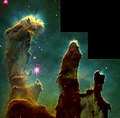
(animation; 0:15; 11 November 2022)

Pillars of Creation is a photograph taken by the Hubble Space Telescope that depicts elephant trunks of interstellar gas and dust in the Eagle Nebula of the Serpens constellation, some 6,500–7,000 light-years (2,000–2,100 pc; 61–66 Em) from Earth. [1] These elephant trunks had been discovered by John Charles Duncan in 1920 on a plate made with the Mount Wilson Observatory 60-inch telescope. [2] [3] They are so named because the gas and dust are in the process of creating new stars, while also being eroded by the light from nearby stars that have recently formed. [4]
Contents
- Name
- Composition
- Theorized destruction
- Photographs
- Original Hubble Space Telescope photo
- Herschel's photo
- Revisits
- See also
- References
- External links
Taken on April 1, 1995, it was named one of the top ten photographs from Hubble by Space.com. [5] The astronomers responsible for the photo were Jeff Hester and Paul Scowen from Arizona State University. The region was rephotographed by ESA's Herschel Space Observatory in 2011, again by Hubble in 2014 with a newer camera, and the James Webb Space Telescope in 2022.
Released in 2007, Chandra X-ray Observatory (AXAF) had observed the area in 2001. It did not find many X-ray sources in the towers but was able to observe sources at various X-ray energy levels in the area from young stars. [6]
The image is noted for its global culture impact, being considered the most iconic picture taken by the Hubble Space Telescope [7] and National Geographic noting on its 20th anniversary that the image had been featured on everything from "t-shirts to coffee-mugs". [8]






